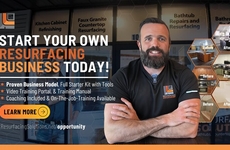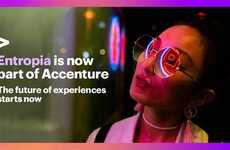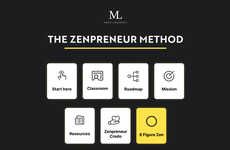
Tiana Reid — April 25, 2011 — Social Good
References: acttrainingco
About six months ago, Social Business covered ACT Training Services, a social enterprise that aims to give individuals the skills they need in order to find employment. Social Business recently interviewed ACT’s Director, Andrea Campbell, for some insight into ACT’s social enterprise model and how she stays inspired.
Four Questions with Andrea Campbell
1. How did the idea for the business model come about?
ACT Training Services specializes in training programs for individuals who are unemployed and seeking to enhance their skills in order to secure and sustain employment.
The social enterprise model came about because we realized that there was a gap in the industry for programs that enabled individuals from disadvantaged communities to boost their confidence and develop technical and soft skills that would herald their entry into the job market. Existing programs appeared very prescriptive and of an inappropriate duration for the client group. The clients often failed to complete the programs and when they did, in many cases they did not gain any recognized qualifications that they could present to an employer.
In order to meet this need and achieve our goals, our programs required support from donor agencies, governmental organizations and philanthropists, bearing in mind that our target group is unemployed people, with very little disposable income. It was clear from the beginning that we would have to raise funds in order to provide the service. The social enterprise model seemed the best strategic fit in this regard.
2. How did you decide to join this sector?
Before the social enterprise was set up, I had been working in a limited company within the regeneration industry. At the time service level agreements were more readily available to private limited companies for training jobseekers. That company ceased operations because the market changed dramatically, leaving it exposed in an industry where it was becoming increasingly difficult to secure contracts.
During my tenure at the limited company I developed an appreciation of the dynamics of the target group and my experience revealed that many clients did not enjoy or benefit from the programs on offer across the industry. Indeed, it appeared as though they were going through the motions in order to keep their state benefits. I observed increased interest in programs they enjoyed and recognized that most of our clients wanted programs that motivated and encouraged them to be creative.
It was clear that the jobseekers with whom we were working needed a different model of learning -– a program in which they had a say; courses that were shorter and that led to a well-defined outcome. They wanted to improve their marketability and in most cases have a qualification that they could “sell” to employers. The model that could deliver this in our view was the one we implemented within ACT Training Services, specializing in the delivery of short, accredited programs, along with soft skills and bespoke vocational training. Our programs last a maximum of five days.
3. How do you get your inspiration?
The motto for our company did not materialize by accident. I have always believed that “Given a chance people will achieve,” and this has been a guiding light since our inception. This idea, combined with my own desire to pursue ventures not just for personal gains but driven by a passion to effect real and lasting change to people’s lives, is the driving force behind ACT Training Services.
Life is not a level playing field but our clients, despite their barriers, are encouraged to defy the odds and to venture deep within themselves and identify talents, latent skills and competences that will position them to create their own future and impact positively on their community. Our clients replace self-pity with empowerment and vulnerability with positive action. They learn to rise up and be counted and to seek out and grasp available opportunities, and to actively pursue self-development and economic fulfillment through channels of employment, education and creativity. We use positive role models to inspire ourselves and our clients and we encourage small, consistent steps that lead to change.
I am inspired when I see my clients rise to the challenge, changing their mindsets and developing self-belief. I am inspired when I observe a paradigm shift as my clients take those small, consistent steps to effect positive change. Needless to say, I am inspired when my clients move to the next level and start to impact positively on the lives of others.
4. How do you reset yourself to be creative? Do you have any rituals?
As a company we are never comfortable with the idea that ‘if something is not broken, there is no need to fix it.’ We continuously seek new and innovative ways to operate, whether by developing new programs or engaging with new methodologies in order to reach our target groups. We are aware of the constant change in technology and other factors and we seek to embrace this change.
I endeavor to attend personal development and training seminars as well as networking events on a regular basis in order to keep abreast of developments in the industry and to apprise myself of new trends and current thinking.
I do not think it is so much about having a ritual that drives creativity; it is more about fostering an environment that nurtures creativity. It is about pooling and leveraging our talents and resources to achieve maximum effect. It is having the ability to look ahead and initiate the necessary preparation to meet future demands and needs. It also means developing good corporate habits while not forgetting the tenets upon which the company is built.
I think that any company that understands the power of change will always seek to massage the creative spirit within the organization or they will ultimately pay the price for failing to acknowledge changing needs and the changing atmosphere of its target markets.
Four Questions with Andrea Campbell
1. How did the idea for the business model come about?
ACT Training Services specializes in training programs for individuals who are unemployed and seeking to enhance their skills in order to secure and sustain employment.
The social enterprise model came about because we realized that there was a gap in the industry for programs that enabled individuals from disadvantaged communities to boost their confidence and develop technical and soft skills that would herald their entry into the job market. Existing programs appeared very prescriptive and of an inappropriate duration for the client group. The clients often failed to complete the programs and when they did, in many cases they did not gain any recognized qualifications that they could present to an employer.
In order to meet this need and achieve our goals, our programs required support from donor agencies, governmental organizations and philanthropists, bearing in mind that our target group is unemployed people, with very little disposable income. It was clear from the beginning that we would have to raise funds in order to provide the service. The social enterprise model seemed the best strategic fit in this regard.
2. How did you decide to join this sector?
Before the social enterprise was set up, I had been working in a limited company within the regeneration industry. At the time service level agreements were more readily available to private limited companies for training jobseekers. That company ceased operations because the market changed dramatically, leaving it exposed in an industry where it was becoming increasingly difficult to secure contracts.
During my tenure at the limited company I developed an appreciation of the dynamics of the target group and my experience revealed that many clients did not enjoy or benefit from the programs on offer across the industry. Indeed, it appeared as though they were going through the motions in order to keep their state benefits. I observed increased interest in programs they enjoyed and recognized that most of our clients wanted programs that motivated and encouraged them to be creative.
It was clear that the jobseekers with whom we were working needed a different model of learning -– a program in which they had a say; courses that were shorter and that led to a well-defined outcome. They wanted to improve their marketability and in most cases have a qualification that they could “sell” to employers. The model that could deliver this in our view was the one we implemented within ACT Training Services, specializing in the delivery of short, accredited programs, along with soft skills and bespoke vocational training. Our programs last a maximum of five days.
3. How do you get your inspiration?
The motto for our company did not materialize by accident. I have always believed that “Given a chance people will achieve,” and this has been a guiding light since our inception. This idea, combined with my own desire to pursue ventures not just for personal gains but driven by a passion to effect real and lasting change to people’s lives, is the driving force behind ACT Training Services.
Life is not a level playing field but our clients, despite their barriers, are encouraged to defy the odds and to venture deep within themselves and identify talents, latent skills and competences that will position them to create their own future and impact positively on their community. Our clients replace self-pity with empowerment and vulnerability with positive action. They learn to rise up and be counted and to seek out and grasp available opportunities, and to actively pursue self-development and economic fulfillment through channels of employment, education and creativity. We use positive role models to inspire ourselves and our clients and we encourage small, consistent steps that lead to change.
I am inspired when I see my clients rise to the challenge, changing their mindsets and developing self-belief. I am inspired when I observe a paradigm shift as my clients take those small, consistent steps to effect positive change. Needless to say, I am inspired when my clients move to the next level and start to impact positively on the lives of others.
4. How do you reset yourself to be creative? Do you have any rituals?
As a company we are never comfortable with the idea that ‘if something is not broken, there is no need to fix it.’ We continuously seek new and innovative ways to operate, whether by developing new programs or engaging with new methodologies in order to reach our target groups. We are aware of the constant change in technology and other factors and we seek to embrace this change.
I endeavor to attend personal development and training seminars as well as networking events on a regular basis in order to keep abreast of developments in the industry and to apprise myself of new trends and current thinking.
I do not think it is so much about having a ritual that drives creativity; it is more about fostering an environment that nurtures creativity. It is about pooling and leveraging our talents and resources to achieve maximum effect. It is having the ability to look ahead and initiate the necessary preparation to meet future demands and needs. It also means developing good corporate habits while not forgetting the tenets upon which the company is built.
I think that any company that understands the power of change will always seek to massage the creative spirit within the organization or they will ultimately pay the price for failing to acknowledge changing needs and the changing atmosphere of its target markets.
Trend Themes
1. Short Accredited Training Programs - Providing short, accredited programs can lead to better completion rates, qualifications that appeal to employers, and can help fill the gap in skills sets.
2. Social Enterprise Model - The social enterprise model can be a strategic fit for organizations seeking to serve unemployed people, particularly those from disadvantaged communities, who have little disposable income but need support.
3. Continuous Innovation - Continuously seeking new and innovative ways to operate, developing new programs, engaging with new methodologies, and embracing changes can help companies or organizations stay relevant and meet future demands and needs.
Industry Implications
1. Education and Training Industry - There is an opportunity for the education and training industry to explore the use of short, accredited programs to help individuals advance their skills and enter the job market.
2. Non-profit Industry - The social enterprise model can provide non-profits with a strategic fit for programs that serve unemployed or disadvantaged people.
3. Corporate Learning and Development Industry - There is an opportunity for companies to innovate continuously, embracing new methodologies and technologies to enhance learning and development programs that help employees progress and stay updated in their fields.
1.3
Score
Popularity
Activity
Freshness























